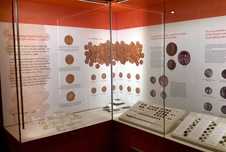Crowds flock to Sandridge Roman Gold Coin Hoard at Verulamium Museum
The Sandridge Gold Coin Hoard was visited by over 500 people when it went on permanent display at Verulamium Museum on Saturday 12 September.
The historic event was celebrated throughout the weekend with Roman-themed activities organised by St Albans City and District Council’s museums’ service.
‘Gaius Allius of Legion XIII’ was on duty to tell visitors what it was like to be a Roman soldier. A ‘mosaicist’ and a ‘wealthy landowner’ described their lives in the late Romano-British era and the landowner explained why he was burying his money.
Visitors learned more about the Sandridge Coin Hoard in a talk by Curator David Thorold who described the historical significance of the coins.
The 159 coins were found by a metal detectorist on private land to the north of St Albans, in Hertfordshire, in 2012. They make up one of the largest hoards of Roman gold coins found in the UK and date from the late fourth to early fifth centuries.
The coins are treasure, under the Treasure Act 1996. As such they were handled through the British Museum’s Portable Antiquities’ Scheme, a voluntary initiative to record archaeological objects found by members of the public.
The coins were purchased for £98,500. The purchase was made possible with the generous support of the Heritage Lottery Fund, St Albans Museums and Galleries Trust, local donors and an overseas benefactor.
Cllr Annie Brewster, Portfolio Holder for Sport, Leisure and Heritage for St Albans City and District Council, said: “I am thrilled that so many people flocked to see our City’s remarkable brand new collection of gold coins in its first weekend on show. They are of huge historical significance since no similar hoards of this period or size have been found in the UK. We can only guess at the reasons why they came to be buried but we can all enjoy the story of how they came to be found by an amateur metal detectorist.
“I am enormously grateful to everyone who has made it possible for this unique collection finally to go on show at Verulamium Museum. We can all now share more of our extraordinary heritage.”
David Thorold, Prehistory to Medieval Curator at Verulamium Museum in St Albans said: “Gold coins, known as solidi, were extremely valuable and were not traded or exchanged on a regular basis in Roman Britain. They would have been used for large transactions such as buying land or goods by the shipload.
“Evidence suggests these coins formed part of a buried hoard that had been disturbed at some point during the last couple of hundred years by, for example, ploughing. During the Roman occupation of Britain, people buried coins for two reasons, either as a sacrifice to their Gods or as a form of secure storage. In the latter case, this would be a temporary measure to protect their wealth when faced with a threat of war or while undertaking a long journey.”
“The coins date to the closing years of the fourth century and start of the fifth. They were issued under five Roman emperors: Gratian, Valentinian II, Theodosius, Arcadius and Honorius. They would have been made in the western mints of the Empire, mostly in the Italian cities of Milan, Rome and Ravenna.”
Councillor contact:
Cllr Annie Brewster, Portfolio Holder for Sport, Leisure and Heritage, St Albans City and District Council, Tel: 01438 832255
Contact for the media:
Ruth Boyer, Communications Officer, St Albans City and District Council
Tel: 01727 819316
E-mail: ruth.boyer@stalbans.gov.uk
Follow us on Twitter: http://twitter.com/StAlbansCouncil
Notes:
1. St Albans City and District Council’s museums’ service runs Verulamium Museum in St Michael’s Street. It also manages the medieval clock tower in the High Street, a field archaeology unit and associated excavations. For more information, please call 01727 751810 or visit https://www.stalbansmuseums.org.uk/
2. Work is underway to raise funds to transform St Albans’ grade II* listed Town Hall into a new museum and art gallery. This will provide a new home for the Museum of St Albans. The Council is working with St Albans Museums and Galleries Trust and the University of Hertfordshire Galleries on the project. Architects’ plans have been developed and will be used to support an application to secure a total of £2.8m from the Heritage Lottery Fund. In addition, the St Albans Museums and Galleries Trust is seeking to raise a further £1.7 million through its ‘renaissance: St Albans’ campaign. More information about the fundraising campaign can be found at https://www.stalbansmuseumsandgalleriestrust.org.uk/projects-2/renaissance-st-albans/
Pictures:
[TOP] One of the gold coins, both before and after it was cleaned to go on display. The coin is a solidus, showing Honorius and his brother Arcadius, Emperors of the Eastern and Western Roman Empires, wearing their robes of office and seated side by side.

